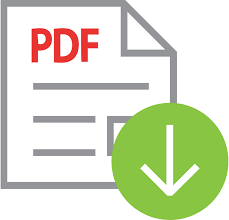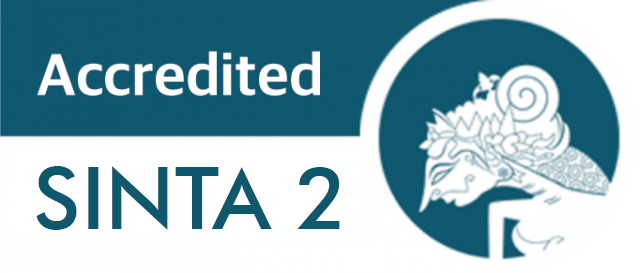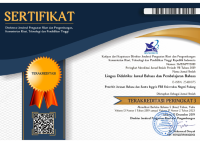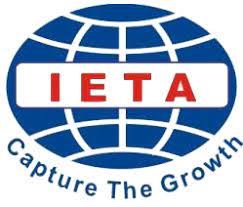Enhancing English Test Preparation through Mobile-Learning: Development of Poliban English Preparation Test Application
 ), Fitria Fitria(2), Manna Dey(3),
), Fitria Fitria(2), Manna Dey(3), (1) Politeknik Negeri Banjarmasin
(2) Politeknik Negeri Banjarmasin
(3) World University of Bangladesh
 Corresponding Author
Corresponding Author
Copyright (c) 2024 Lingua Didaktika: Jurnal Bahasa dan Pembelajaran Bahasa
DOI : https://doi.org/10.24036/ld.v18i2.130223
Full Text:
 Language : en
Language : en
Abstract
One strategy to optimize TOEIC learning and preparation is to facilitate students to learn anytime and anywhere with materials and exercises through technology integration, specifically a smartphone application. Therefore, this research aims to design a product called the Poliban English Preparation Test Application (PEPTA), which contains listening and reading materials and exercises in TOEIC format. By increasing students' TOEIC scores, this research is expected to contribute to enhancing students' English proficiency through better preparation, increasing the number of overseas scholarship awardees (IISMAVO), and improving foreign language exit test scores in Politeknik Negeri Banjarmasin (Poliban). The research questions to be addressed are: (1) What are the needs of potential users of the application? (2) How can TOEIC materials and exercises be developed in this application-based format? This research employed the Research and Development (R&D) method with the ADDIE model limited to product try-out in implementation stage. There are 383 students from Poliban, Muhammadiyah University of Banjarmasin, and the World University of Bangladesh at the needs analysis stage and 34 students at the try-out of PEPTA. The instruments to be used in this stage include needs analysis questionnaires, an interview guide, validation sheets during product validation, and a questionnaire on the product try out. Data was collected and analyzed. The results showed that the developed product/ PEPTA is valid and practical with the score of 3.63, indicating high practicality. However, there is still room for improvement to maximum students’ scores.
Keywords
References
Ahmad, T. (2020). Student Perceptions on Using Cell Phones as Learning Tools: Implications for Mobile Technology Usage in Caribbean Higher Education Institutions. PSU Research Review, 4(1), 25–43. https://doi.org/10.1108/PRR-03-2018-0007
Ahmed, R. (2016). Effectiveness of Reading English Newspapers for Improving Vocabulary and Reading Skills of Students of Dhaka University. The Millennium University Journal, 1(1), 68–76.
Al-Shamaileh, O., & Sutcliffe, A. (2023). Why People Choose Apps: An Evaluation of the Ecology and User Experience of Mobile Applications. International Journal of Human Computer Studies, 170. https://doi.org/10.1016/j.ijhcs.2022.102965
Amalia, F. (2023). A Need Analysis for Learning English to Young Learners. Teaching & Learning English in Multicultural Contexts, 7(1). http://jurnal.unsil.ac.id/index.php/tlemc/index
Anaktototy, K., & Lesnussa, I. (2022). Improving EFL Students’ Reading Comprehension and Critical Thinking Skill through Directed Reading Thinking Activity. 6(1). https://ojs.unm.ac.id/eralingua
Bilgin, E. A. (2021). Developing a Mobile Application to Improve the Levels of Statistical Literacy among Graduate Students. International Journal of Education and Literacy Studies, 9(4), 113. https://doi.org/10.7575/aiac.ijels.v.9n.4p.113
Bui, H. P., Hung, H., Bui, P., Dinh, D., Bui, P. H., Bui, H. H. P., & Dinh, P. D. (2023). Vietnamese Students’ Use of Smartphone Apps in English Learning. Journal: Language Education and Acquisition Research Network, 16(1), 28–46. https://so04.tci-thaijo.org/index.php/LEARN/index
Burapharat, Y., & Tiansoodeenon, M. (2022). Developing Guidelines to Enhance TOEIC Testing Score and Improving English Learning Method of Students in Aviation Field [Unpublished Thesis]. In APDI KBU. Aviation Personnel Development Institute Kasem Bundit University.
Cheng, Y.-S. (2002). Factors Associated with Foreign Language Writing Anxiety. Foreign Language Annals, 35(5), 647–656.
Dick, W., Carey, L., & Carey, J. O. (2015). The Systematic Design of Instruction (M. Fosell, Ed.; Eight Edition). Pearson.
ETS TOEIC. (2022). TOEIC 2022 Listening Reading Report Test Takers Worldwide.
Febriyanti, E. R., Fadilla, R., Pasani, C. F., & Amelia, R. (2022). NovoLearning: A Strategic Response to Large Class Problems in Teaching Non-English Department Students. JOALL (Journal of Applied Linguistics and Literature), 7(2), 395–412. https://doi.org/10.33369/joall.v7i2.20117
Gokgoz, Z. A., Ataman, M. B., & Bruggen, G. H. van. (2021). There’s an App for that! Understanding the Drivers of Mobile Application Downloads. Journal of Business Research, 123, 423–437. https://doi.org/10.1016/j.jbusres.2020.10.006
Hadjerrouit, S. (2012). Investigating Technical and Pedagogical Usability Issues of Collaborative Learning with Wikis. Informatics in Education, 11(1), 45–64.
Hsieh, C. (2017). The Case of Taiwan: Perceptions of College Students About the Use of the TOEIC ® Tests as a Condition of Graduation . ETS Research Report Series, 2017(1), 1–12. https://doi.org/10.1002/ets2.12179
Hsieh, C. N. (2023). Interpretation and Use of a Workplace English Language Proficiency Test Score Report: Perspectives of TOEIC® Test Takers and Score Users in Taiwan. ETS Research Report Series, 2023(1), 1–21. https://doi.org/10.1002/ets2.12373
Jehma, H., & Akaraphattanawong, A. (2023). VRChat as a Virtual Learning Platform for Enhancing English Listening Skills. International Journal of Information and Education Technology, 13(5), 813–817. https://doi.org/10.18178/ijiet.2023.13.5.1872
Kim, N. Y. (2022). AI-integrated Mobile-Assisted Language Learning: Is It an Effective Way of Preparing for the TOEIC Test in Classroom Environments? English Teaching(South Korea), 77(3), 79–102. https://doi.org/10.15858/engtea.77.3.202209.79
Klimova, B., & Zamborova, K. (2020). Use of Mobile Applications in Developing Reading Comprehension in Second Language Acquisition —A Review Study. In Education Sciences (Vol. 10, Issue 12, pp. 1–11). MDPI AG. https://doi.org/10.3390/educsci10120391
Kondo, M., Ishikawa, Y., Smith, C., Sakamoto, K., Shimomura, H., & Wada, N. (2012). Mobile Assisted Language Learning in University EFL Courses in Japan: Developing Attitudes and Skills for Self-Regulated Learning. ReCALL, 24(2), 169–187. https://doi.org/10.1017/S0958344012000055
Koowuttayakorn, S., & Taylor, P. (2022). Usability and Motivation Study of Mobile Application for English Language Proficiency Test Preparation in Thailand: A Case Study of TU-GET CBT. Journal: Language Education and Acquisition Research Network, 15(2), 625–648. https://so04.tci-thaijo.org/index.php/LEARN/index
Krüger, M. (2023). Media-Related Out-of-School Contact with English in Germany and Switzerland Frequency, Forms and the Effect on Language Learning. Springer VS.
Lai, Y., Saab, N., & Admiraal, W. (2022). Learning Strategies in Self-directed Language Learning Using Mobile Technology in Higher Education: A Systematic Scoping Review. Education and Information Technologies, 27(6), 7749–7780. https://doi.org/10.1007/s10639-022-10945-5
Mulyadi, D., & Aimah, S. (2021). Android-Based Mobile Learning Media in Teaching Reading of Report Texts. Getsempena English Education Journal (GEEJ), 8(1).
Musta’in, M. M., Muafiqie, H., Karman, A., Kalsum, U., Novita, D., Keling, M., Rahman, A., Trimulato, T., Khasanah, R., Nasib, N., Utami, M. P., & Nasuka, M. (2022). Ekonomi Kreatif Berbasis Digital dan Kemandirian Masyarakat Era Society 5.0 (A. A. Seto, Ed.; First Edition). CV. Global Aksara Pers.
Nae, N. (2023). Cultivating Effective Communication Skills in TOEIC Classes: Moving Beyond Drills. Innovation in Language Learning International Conference, 1–4. http://jaltpublications.org/proceedings/issues/2013-08_2012.1
Nguyen, H., & Gu, Y. (2020). Impact of TOEIC Listening and Reading as a University Exit Test in Vietnam. Language Assessment Quarterly, 17(2), 147–167. https://doi.org/10.1080/15434303.2020.1722672
Nguyen, H. T. N., Phan, T. M. U., Huynh, T. M. D., & Tran, T. K. H. (2020). Difficulties in Studying TOEIC Listening Comprehension of Non–English Majored Freshmen at Tay Do University, Vietnam. European Journal of English Language Teaching, 6(1). https://doi.org/10.46827/ejel.v6i1.3297
Nguyen, N. H. T., & Kim, T. K. (2021). Difficulties in Reading Comprehension of English Majored Sophomores at Tay Do University, Cantho, Vietnam. European Journal of English Language Teaching, 6(3). https://doi.org/10.46827/ejel.v6i3.3590
Oranpattanachai, P. (2023). Relationship between the Reading Strategy, Reading Self-Efficacy, and Reading Comprehension of Thai EFL Students. Journal: Language Education and Acquisition Research Network, 16(1), 194–220. https://so04.tci-thaijo.org/index.php/LEARN/index
Pan, Y.-C., & In’nami, Y. (2017). Does TOEIC as a University Exit Test Ensure Higher Employability in Taiwan? International Journal of Language Testing, 7(1).
Park, S., Kwak, E. J., Tak, J. young, & Tate, T. (2020). Investigation on TOEIC score trends in Korea and its pedagogical implications. Cogent Education, 7(1). https://doi.org/10.1080/2331186X.2020.1796557
Pikhart, M., Klimova, B., & Al-Obaydi, L. H. (2024). Exploring University Students’ Preferences and Satisfaction in Utilizing Digital Tools for Foreign Language Learning. Frontiers in Education, 9. https://doi.org/10.3389/feduc.2024.1412377
Powers, D. E. (2013). Assessing English-Language Proficiency in All Four Language Domains: Is It Really Necessary?
Ristra, P., Arum Budiana, A., & Bathin Alam-Sungai Alam, J. (2023). An Analysis of TOEIC Test Prep Application on the Student’s Listening Comprehension at State Polytechnic of Bengkalis. INOVISH JOURNAL, 8(1).
Rutson-Griffiths, Y., & Rutson-Griffiths, A. (2020). The Relationship between Independent Study Time, Self-Directedness, and Language Gain. SiSal Journal, 11(1), 24–39. https://doi.org/10.37237/110103
Schmidgall, J. E. (2017). Articulating and Evaluating Validity Arguments for the TOEIC ® Tests . ETS Research Report Series, 2017(1), 1–9. https://doi.org/10.1002/ets2.12182
Schmidgall, J., & Powers, D. E. (2021). Predicting Communicative Effectiveness in the International Workplace: Support for TOEIC® Speaking Test Scores from Linguistic Laypersons. Language Testing, 38(2), 302–325. https://doi.org/10.1177/0265532220941803
Sittisuwan, N. (2019). Expectations of Thai Undergraduate Students on Future Employability Based on their TOEIC Score: Evidence from a Human Resource Perspective. Thammasat University.
Sumaira, Q., Asaf Amir, M., Shafiq, Q., Arafat, Y., Gulfraz Abbasi, M., Multan Punjab Pakistan, P., & Professor, A. (2022). Developing Reading Comprehension Skills among the Students at University Level. Journal of Archaeology of Egypt, 19(1), 464–478.
Suppasetseree, S., Kumdee, S., & Ho Minh, T. (2023). Supporting Student Engagement with Technology: Findings from a Study of an Online Personal Learning Environment for Extensive Listening. LEARN Journal: Language Education and Acquisition Research Network, 16(2), 220–240. https://so04.tci-thaijo.org/index.php/LEARN/index
Tso, H.-C., & Chwo, G. S.-M. (2019). Online Proficiency Testing and Intensive Course Improvement of English Instruction at a Technology University in Taiwan. Journal of Thai Interdisciplinary Research, 14(2), 8–15.
Wakhidah, R., Farid Maftuh, M., & Maaliah, E. (2019). Pengembangan Aplikasi Listening Test Berbasis Android. In Journal of Applied Informatics and Computing (JAIC) (Vol. 3, Issue 2). http://jurnal.polibatam.ac.id/index.php/JAIC
Wei, Y., & Low, A. (2017). Monitoring Score Change Patterns to Support TOEIC ® Listening and Reading Test Quality . ETS Research Report Series, 2017(1), 1–20. https://doi.org/10.1002/ets2.12186
Widyaningrum, E. N. (2020). Pengembangan Aplikasi TOEIC Preparation Berbasis Web sebagai Sarana Pembelajaran Taruna di Politeknik Penerbangan Surabaya. Seminar Nasional Inovasi Teknologi Penerbangan (SNITP), 1–4.
 Article Metrics
Article Metrics
 Abstract Views : 100 times
Abstract Views : 100 times
 PDF Downloaded : 32 times
PDF Downloaded : 32 times
Refbacks
- There are currently no refbacks.
Copyright (c) 2024 Lingua Didaktika: Jurnal Bahasa dan Pembelajaran Bahasa

This work is licensed under a Creative Commons Attribution-NonCommercial 4.0 International License.









